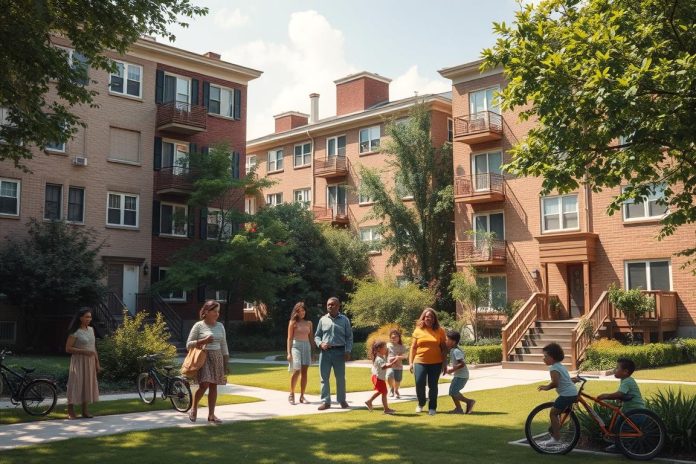Imagine a world where your housing isn’t stressful, but a base of stability. Many in New York State see this not as a dream, but as a real chance. This is thanks to a strong network of public housing assistance programs. Initiatives like the Low-Income Housing Tax Credit (LIHTC) have added nearly 3 million units1. And, state efforts further push for more affordable living places. Government housing aid and subsidy programs are key for keeping dignity and helping communities grow.
In 2020, states got a lot of money for LIHTC, showing the government’s dedication to affordable housing1. The Housing Choice Voucher program helped over 5 million people1. It’s clear that the goal is to offer not just houses, but hope too.
Key Takeaways
- Discover how public housing assistance can transform your living situation into one of comfort and assurance.
- Learn about the diverse range of affordable housing programs designed to cater to low-income families and individuals in New York State.
- Find out how government housing aid functions to foster safe and affordable communities.
- Understand the power of housing subsidy programs in uplifting lives and building a stable foundation for those in need.
- Get informed on the fiscal investments, such as the LIHTC allocations, that spark change and affordability in the housing sector1.
Understanding Public Housing Assistance and Eligibility
Public housing assistance is crucial for providing subsidized housing assistance. It helps around 970,000 households find affordable homes across many areas2. Managed by about 3,300 Housing Authorities, it aims to give stable homes to low-income families who qualify2.
In 2023, the federal government put $67 billion into housing assistance. This shows a strong commitment to solving the affordable housing issue3. Of this, $8 billion supports public housing programs. It helps improve living conditions for many people3.
To join these programs, knowing the rules is key. Families must earn below set income limits. HUD sets these at 80% for low and 50% for very low incomes, based on area medians2. This helps ensure that rent assistance for low-income families reaches those in greatest need.
Rent calculations aim to be fair. The Total Tenant Payment (TTP) formula looks at a family’s income and deductions. This way, people aren’t paying more than they can afford2. Every 12 months, incomes are checked to adjust rents. This keeps living costs manageable for tenants2.
Project-based rental help gets $15 billion for building and maintaining housing sites3. This low income housing support also boosts local economies by funding community projects3.
In urgent cases, emergency housing assistance like the ERA Program is vital. In 2023, it got significant funds, showing its key role in housing help3.
For families looking into housing assistance, learning about resources and rules is the first step to finding affordable homes. These programs not only provide housing but also strengthen communities. They lay the groundwork for social well-being and growth.
Section 8 and Housing Choice Vouchers: A Lifeline for Low-Income Families
Section 8 vouchers and Housing Choice Vouchers are more than just financial support. They stand for the hope of finding a stable, safe, and affordable home. For those seeking rent assistance for low-income families, knowing how to get these vouchers is essential. The first step is contacting the local Section 8 administrator to see if you qualify, usually meaning your income must be below 50% of the area’s median income4.
Applying for Section 8 Vouchers
Starting the journey towards government housing aid can seem overwhelming. But, with proper guidance, the steps to apply for public housing assistance become clearer. You must complete several eligibility checks, including your family size, citizenship, and criminal history5. Once approved, an important interview follows with your local Public Housing Agency (PHA) to provide necessary documents and discuss housing needs4.
The Role of Local PHAs in Section 8
Local Public Housing Agencies (PHAs) play a key role in managing affordable housing programs. They not only check if applicants qualify but also handle the lengthy waitlists due to high demand and limited voucher availability. Therefore, keeping your information current with your PHA is crucial4.
Locating Section 8 Rentals
Searching for Section 8 approved rentals can be tough. The good news is there are helpful tools like the NY Housing Search platform. This service helps New York residents find affordable housing that meets their needs, such as being in a good school district or having accessible features, any time they need it. Through cooperation with PHAs and incentives for landlords, securing a good place becomes easier4.
For more on the challenges low-income Detroit families face in obtaining these crucial vouchers and the unused resources making it harder, visit Outlier Media4.
FAQ
What types of public housing assistance programs are available in New York State?
Who is eligible for affordable housing programs in New York?
How can organizations obtain grants for housing construction and renovation?
How do Section 8 vouchers help low-income families?
How does one apply for Section 8 vouchers?
What is the role of Local Public Housing Agencies (PHAs) in administering Section 8 vouchers?
Where can I find rentals that accept Section 8 vouchers?
Are there any assistance programs for emergencies or immediate housing needs?
Source Links
- Federal programs for affordable housing – Local Housing Solutions – https://localhousingsolutions.org/fund/federal-programs-for-affordable-housing/
- HUD’s Public Housing Program – https://www.hud.gov/topics/rental_assistance/phprog
- The Federal Government’s Support for Low-Income Housing Expanded during the Pandemic – https://www.pgpf.org/blog/2024/04/how-does-the-federal-government-support-housing-for-low-income-households
- How to Qualify, Apply & Get Section 8 Voucher in California? – https://affordablehousing.complianceprime.com/articles/how-to-get-a-section-8-voucher-in-california-5-easy-steps/
- California – https://www.hud.gov/ca

